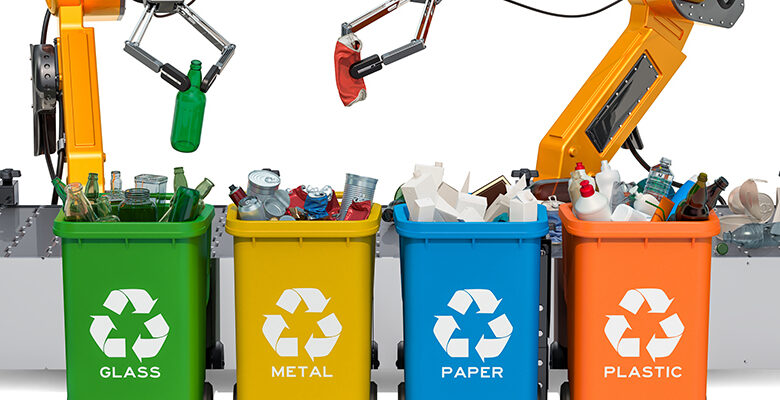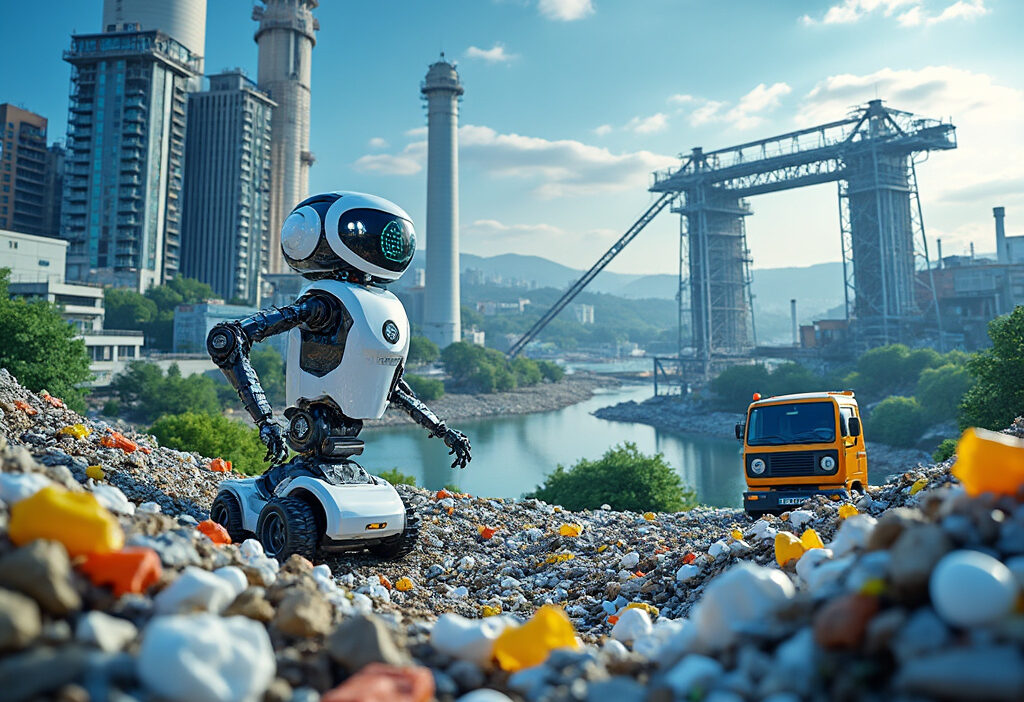Revolutionizing Waste Management
By 2025, the landscape of waste management has been transformed through cutting-edge innovations and a profound commitment to sustainability. This evolution is marked by the integration of artificial intelligence, robotics, advanced recycling technologies, and circular economy principles. Together, these trends are setting unprecedented standards in resource recovery, efficiency, and environmental preservation.
The Dawn of a New Era in Waste Management
The waste management sector is undergoing a seismic shift, moving away from outdated landfill-dependent models toward a future where innovation and sustainability drive progress. By 2025, the industry is embracing circular economy principles, integrating advanced technologies, and redefining waste as a resource rather than a burden. Traditional linear systems—collect, dump, forget—are being replaced by dynamic, data-driven processes that prioritize recovery, reuse, and regeneration.
One of the most transformative changes is the adoption of smart waste collection systems. IoT-enabled bins equipped with fill-level sensors optimize pickup routes, reducing fuel consumption and emissions. These systems communicate in real-time with waste management hubs, ensuring timely interventions and minimizing overflow. Meanwhile, blockchain technology is enhancing traceability, allowing stakeholders to track waste streams from origin to final disposition, ensuring compliance with stringent Extended Producer Responsibility (EPR) regulations.
Material Recovery Facilities (MRFs) are also evolving, though their advancements will be detailed in the next chapter. Here, it’s critical to note that their modernization is part of a broader ecosystem shift—where biodegradable waste is increasingly diverted to anaerobic digesters, producing biogas and organic fertilizers, while chemical recycling breaks down plastics into their base molecules for infinite reuse.
Regulatory pressures and corporate sustainability goals are accelerating these innovations. Governments worldwide are imposing stricter landfill taxes and mandating higher recycling rates, pushing industries to adopt zero-waste-to-landfill strategies. Meanwhile, businesses are recognizing the economic potential of waste valorization, turning byproducts into revenue streams. This new era isn’t just about managing waste—it’s about erasing the concept of waste altogether.
Artificial Intelligence and Robotics Lead the Way
The integration of artificial intelligence (AI) and robotics into Material Recovery Facilities (MRFs) has transformed waste sorting from a labor-intensive, error-prone process into a highly efficient, automated operation. Advanced AI-powered optical sorters now identify and separate materials with unprecedented accuracy, distinguishing between plastics, metals, paper, and even complex composites. These systems leverage deep learning algorithms trained on vast datasets, enabling them to adapt to new waste streams and contamination patterns in real time.
Robotic arms, equipped with AI-driven vision systems, have become indispensable in MRFs. They work alongside human operators, handling hazardous or hard-to-sort materials while reducing workplace injuries. For example, robots can precisely pick out lithium-ion batteries from e-waste streams—a critical safety improvement given their fire risk. This synergy between humans and machines not only boosts sorting speeds but also ensures compliance with Extended Producer Responsibility (EPR) mandates by achieving higher purity rates in recycled outputs.
AI also optimizes facility operations by predicting equipment maintenance needs and adjusting sorting lines dynamically based on incoming waste composition. This minimizes downtime and maximizes resource recovery. Furthermore, AI analytics help MRFs meet regulatory reporting requirements by automatically tracking material flows, contamination levels, and recycling rates—key metrics under EPR frameworks.
As waste streams grow more complex, AI and robotics provide the scalability needed to keep pace. The next frontier lies in integrating these systems with video analytics and IoT sensors, setting the stage for even smarter, data-driven waste management—a topic we’ll explore next.
Leveraging Video and Data Analytics
The integration of video technology and data analytics is transforming waste management operations, offering unprecedented visibility and control over processes. By leveraging high-resolution cameras and advanced analytics, facilities can monitor waste streams in real time, ensuring higher purity rates and reducing contamination. For instance, optical sorting systems equipped with video analytics can identify and separate non-recyclable materials with precision, complementing the AI-driven robotics discussed earlier.
In fleet management, video analytics play a crucial role in optimizing routes and improving driver behavior. Dashcams and onboard sensors capture data on vehicle performance, idle times, and route deviations, which analytics platforms process to minimize fuel consumption and emissions. This not only cuts operational costs but also aligns with sustainability goals by reducing the carbon footprint of waste collection.
Another critical application is waste stream monitoring. Smart cameras installed at transfer stations and MRFs analyze the composition of incoming waste, flagging contaminants before they enter the recycling chain. Data from these systems feeds into predictive models, allowing operators to adjust sorting parameters dynamically. This reduces manual intervention and enhances compliance with Extended Producer Responsibility (EPR) mandates by ensuring cleaner material outputs.
Furthermore, contamination reduction is significantly improved through video-based audits. Facilities can track and document contamination sources, enabling targeted education campaigns for residents and businesses. When combined with IoT and sensor networks—covered in the next chapter—this creates a closed-loop system where data from bins, trucks, and processing plants synergize for end-to-end efficiency.
By harnessing video and analytics, waste management evolves from reactive to proactive, minimizing waste, maximizing recovery, and paving the way for a circular economy.
The Role of IoT and Sensor Networks
The integration of IoT devices and sensor networks has transformed waste management into a data-driven, highly efficient system. By embedding smart sensors in bins, dumpsters, and collection vehicles, municipalities and waste management companies now have real-time visibility into waste levels, composition, and collection patterns. These sensors transmit data via wireless networks, enabling dynamic adjustments to collection schedules and routes, minimizing unnecessary pickups and fuel consumption.
One of the most significant advancements is the use of fill-level sensors in waste containers. These sensors detect when bins are nearing capacity, triggering automated alerts to dispatch collection teams only when needed. This eliminates the inefficiency of fixed schedules, reducing vehicle mileage by up to 30% in some urban deployments. Additionally, weight sensors and composition analyzers help track waste types, ensuring proper sorting and reducing contamination—complementing the video analytics discussed earlier.
Fleet operations have also benefited from IoT-enabled telematics. GPS and onboard diagnostics monitor vehicle performance, idling times, and fuel efficiency, allowing operators to optimize routes dynamically. This not only cuts emissions but also extends vehicle lifespan. When combined with predictive analytics, sensor data can forecast maintenance needs, preventing costly breakdowns and service interruptions.
Looking ahead, IoT networks will integrate with electric and hydrogen fleets, as covered in the next chapter, to further streamline operations. By merging sensor-driven insights with clean energy vehicles, waste management systems can achieve unprecedented sustainability, reducing both environmental impact and operational costs. The future of waste management lies in this seamless fusion of smart technology and eco-conscious infrastructure.
Greening the Fleet
The shift toward electric and hydrogen-powered waste collection vehicles marks a pivotal step in decarbonizing urban waste management. As cities worldwide strive to meet sustainability targets, fleets traditionally reliant on diesel are being replaced by zero-emission alternatives, drastically cutting greenhouse gas emissions and noise pollution. Electric waste trucks, powered by high-capacity lithium-ion or solid-state batteries, are now capable of handling full-day operations on a single charge, thanks to advancements in energy density and regenerative braking systems. Meanwhile, hydrogen fuel cell vehicles offer extended range and rapid refueling, making them ideal for larger municipalities with demanding routes.
The environmental benefits are substantial. A single electric waste truck can reduce CO2 emissions by up to 100 metric tons annually compared to diesel counterparts. When paired with renewable energy sources for charging or hydrogen production, the carbon footprint drops even further. Beyond emissions, operational costs see a dramatic decline—electric vehicles require fewer moving parts, reducing maintenance expenses by up to 40% over their lifecycle. Fleet operators also benefit from predictive analytics, integrating data from IoT-enabled vehicles (as discussed in the previous chapter) to optimize charging schedules and route efficiency.
Governments and private waste management firms are accelerating adoption through subsidies and pilot programs. Cities like Oslo and Los Angeles have already deployed fully electric fleets, demonstrating scalability. However, challenges remain, including upfront costs and charging infrastructure gaps. As the industry evolves, innovations in battery recycling and green hydrogen production will further enhance viability, paving the way for the next wave of advanced recycling technologies discussed in the following chapter.
Pushing the Envelope with Advanced Recycling Technologies
Traditional recycling methods struggle with complex waste streams, often leading to inefficiencies and contamination. In 2025, advanced recycling technologies are revolutionizing waste management by tackling these challenges head-on. Innovations like chemical recycling break down plastics at the molecular level, enabling the recovery of high-quality materials from previously non-recyclable items, such as multi-layered packaging or heavily soiled plastics. Unlike mechanical recycling, which degrades material quality over time, these processes restore polymers to near-virgin condition, closing the loop more effectively.
Another breakthrough is AI-powered sorting systems, which use machine learning and hyperspectral imaging to identify and separate materials with unprecedented accuracy. These systems reduce contamination rates—a major hurdle in traditional recycling—by distinguishing between similar-looking plastics, metals, and composites. This not only improves the purity of recycled outputs but also lowers processing costs, making recycling more economically viable.
However, technology alone isn’t enough. Consumer education remains critical in minimizing contamination at the source. Smart bins equipped with real-time feedback mechanisms guide users on proper waste segregation, while gamified mobile apps incentivize correct disposal habits. Municipalities are also leveraging data analytics to identify contamination hotspots and tailor outreach programs accordingly.
As waste management shifts toward a circular economy—highlighted in the next chapter—these advanced recycling methods ensure that materials stay in use longer, reducing reliance on landfills and virgin resources. Combined with the decarbonization efforts of electric and hydrogen fleets (discussed earlier), these innovations create a more sustainable, efficient waste ecosystem for 2025 and beyond.
Embracing Circular Economy for Sustainable Growth
The shift toward a circular economy is transforming waste management from a linear disposal model into a dynamic system where materials are continuously repurposed, energy is recovered, and communities are actively engaged. Waste management companies are no longer just collectors and disposers—they are becoming key players in resource optimization, leveraging innovation to keep materials in circulation and reduce dependency on virgin resources.
One of the most significant advancements is the repurposing of waste into high-value materials. Companies are investing in chemical recycling and bio-refining to break down plastics, textiles, and organic waste into reusable feedstocks for manufacturing. For example, discarded PET bottles are being converted into food-grade packaging, while agricultural waste is processed into biodegradable polymers, closing the loop on material lifecycles.
Renewable energy generation from waste is another pillar of this transformation. Landfills are being retrofitted with biogas capture systems, and advanced waste-to-energy plants now employ gasification to produce clean syngas for electricity and hydrogen fuel. These innovations not only divert waste from landfills but also contribute to decarbonization efforts, aligning with global sustainability goals.
Community involvement is equally critical. Waste management firms are partnering with local governments to implement zero-waste initiatives, offering incentives for households and businesses to separate recyclables and compostables effectively. Digital platforms enable real-time tracking of waste streams, empowering consumers to make informed decisions about their disposal habits.
By embracing circular economy principles, the industry is proving that waste is not an endpoint but a resource waiting to be reclaimed. This systemic shift sets the stage for the next wave of innovations—where AI, smart infrastructure, and data analytics will further refine efficiency, as explored in the following chapter.
Innovation at the Forefront of Industry Outlook
At WasteExpo 2025, the buzz was undeniable—innovation wasn’t just a trend but the backbone of waste management’s future. The industry’s shift toward a circular economy, as highlighted in the previous chapter, has set the stage for groundbreaking tech integration. Now, AI, smart bins, electric fleets, and data analytics are no longer experimental concepts but the new normal, driving efficiency and sustainability at every level.
One standout was the evolution of AI-powered waste sorting. Advanced machine learning algorithms now identify and separate materials with near-perfect accuracy, reducing contamination in recycling streams. Companies like AMP Robotics demonstrated systems that adapt in real-time, learning from each piece of waste processed. Meanwhile, smart bins equipped with IoT sensors have become ubiquitous, optimizing collection routes by transmitting fill-level data to central dashboards. This reduces fuel consumption and emissions, aligning with the industry’s push for zero-waste cities.
Electric waste collection vehicles (WCVs) also took center stage, with major players like Waste Management and Republic Services showcasing fully integrated fleets. These vehicles, powered by renewable energy, slash carbon footprints while maintaining operational efficiency. Analytics platforms further enhance their impact, offering predictive maintenance and route optimization through real-time data.
The excitement wasn’t just about individual technologies but their synergy. Integrated systems now merge AI, IoT, and analytics to create closed-loop waste ecosystems—where every step, from disposal to repurposing, is data-driven. As the industry moves toward the innovations detailed in the next chapter, WasteExpo 2025 proved that the future of waste management isn’t just sustainable; it’s intelligent.
Major Innovations in 2025
By 2025, waste management has undergone a radical transformation, driven by cutting-edge technologies that optimize efficiency, reduce environmental impact, and maximize resource recovery. Artificial Intelligence (AI) and Internet of Things (IoT) have become the backbone of smart waste systems, enabling real-time monitoring and predictive analytics. Companies like WasteIQ and Compology deploy AI-powered sensors in bins to analyze fill levels, composition, and contamination, dynamically adjusting collection routes to minimize fuel use and emissions.
Electric fleets have surged in adoption, with Republic Services and Waste Management Inc. leading the charge by replacing diesel trucks with zero-emission vehicles. These fleets integrate with route optimization software, further cutting operational costs and carbon footprints. Meanwhile, advanced recycling technologies are breaking barriers in material recovery. Chemical recycling startups like Agilyx and PureCycle are converting previously non-recyclable plastics into high-quality raw materials, while AI-driven robotic sorters from AMP Robotics achieve near-perfect separation accuracy at material recovery facilities.
Innovations extend to organic waste as well. Anaerobic digestion systems, enhanced by IoT sensors, now efficiently convert food waste into biogas and fertilizers. Companies like Brightmark and Anaergia are scaling these solutions, turning landfills into energy hubs. Additionally, blockchain-enabled traceability platforms ensure transparency in waste streams, allowing businesses and municipalities to track recycling performance in real time.
These advancements are not just incremental—they represent a systemic shift toward a circular economy. By 2025, waste is no longer seen as trash but as a valuable resource, thanks to technologies that redefine collection, processing, and reuse. The integration of AI, IoT, and clean energy solutions has set a new benchmark, making sustainability an operational imperative rather than an aspirational goal.
Envisioning the Future of Waste Management
By 2030 and beyond, waste management is poised to transcend its traditional role, evolving into a fully integrated, circular ecosystem driven by next-generation technologies and ambitious sustainability goals. Smart cities will leverage AI-powered predictive analytics to optimize waste flows in real time, minimizing landfill reliance by dynamically rerouting materials to the most efficient recycling or upcycling pathways. Autonomous waste-sorting drones, equipped with hyperspectral imaging, could scan urban environments to identify and recover misplaced recyclables before they enter landfills.
The rise of molecular recycling will redefine material recovery, breaking down plastics and composites at the atomic level to create virgin-quality feedstocks—eliminating the need for fossil-fuel-derived plastics altogether. Companies like Carbios and Loop Industries are already pioneering enzymatic and chemical depolymerization, but future iterations may integrate bioengineered microbes to digest even the most complex waste streams, including e-waste and textiles.
Waste-to-energy systems will also undergo a transformation, shifting from incineration to plasma gasification and hydrogen extraction, turning non-recyclables into clean fuels with near-zero emissions. Meanwhile, blockchain-enabled traceability will ensure full transparency across supply chains, incentivizing producers to adopt cradle-to-cradle designs.
Policy frameworks will likely mandate extended producer responsibility (EPR) at a global scale, pushing industries to embed sustainability into product lifecycles. By 2040, waste management could become a net-positive system—generating energy, reclaiming critical raw materials, and even sequestering carbon through biochar production from organic waste. The future isn’t just about managing waste; it’s about erasing the concept of waste itself.

Conclusions
In 2025, waste management witnesses a paradigm shift towards sustainability, fueled by the adoption of advanced technologies and circular economy principles. These innovations are not just revolutionizing waste handling and recycling processes but are also steering the industry towards achieving a zero-waste, net-zero emissions future. The journey showcases the collective commitment to preserving our planet for future generations.



